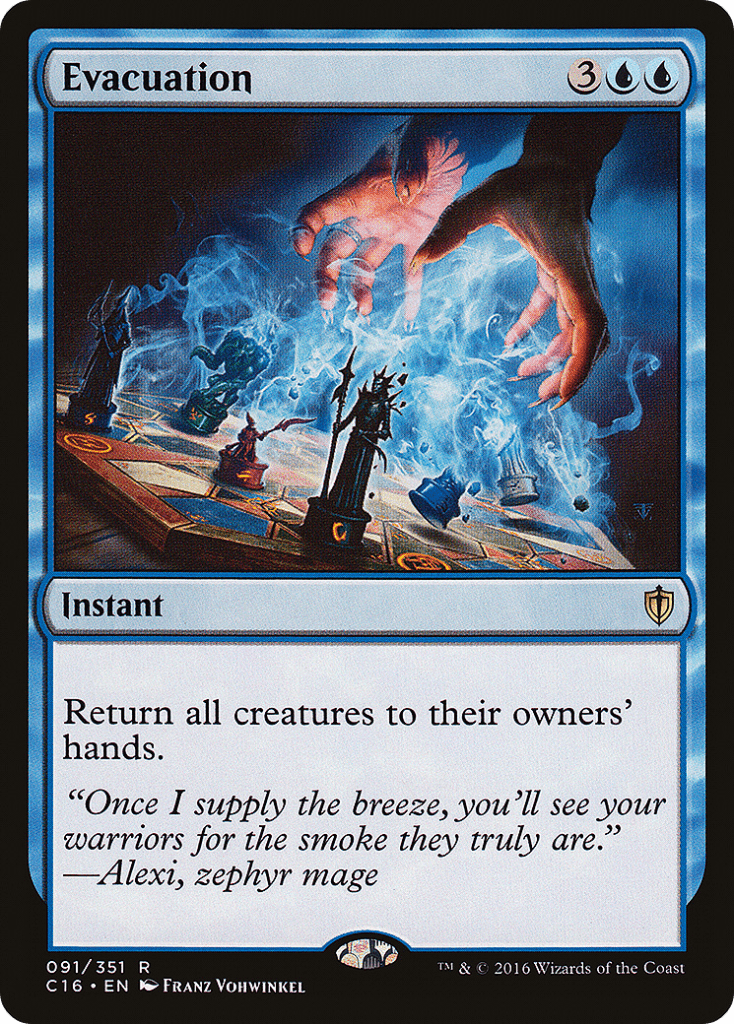
When a Magic: The Gathering player thinks of control, their instinct is to think of blue. With its wealth of efficient counterspells and card draw options, no other color comes close to blue’s prowess when it comes to picking and choosing what spells its opponents are allowed to resolve.
Since card advantage and attrition are vital components of winning control decks and strategies, board wipes, or spells that remove all of a certain type of permanent from the battlefield (usually creatures) are great ways to break parity, remove a lot of opposing resources, and address a lot of potential threats at once.
Board wipes aren’t just for control decks in Commander though; they are great safety valves that can help aggressive and combo decks too! These powerful mass removal spells are often the best tools to address problematic cards from multiple players and/or help you catch up in scenarios where you’ve fallen behind one or more opponents.
How Do Blue’s Best Mass Removal Spells Work?
Blue’s board wipes traditionally return permanents from the battlefield to their owners’ hands, though they can destroy or exile them on rare occasions. While this means a mono blue board wipe usually won’t provide a permanent answer to threats, it forces opponents to cast their best spells a second time, opening them up to countermagic that can.
While temporary removal seems like a pretty big drawback when compared to board wipes that destroy or exile cards, there are a few pretty handy upsides to bouncing permanents back to your opponents’ hand instead of destroying them.
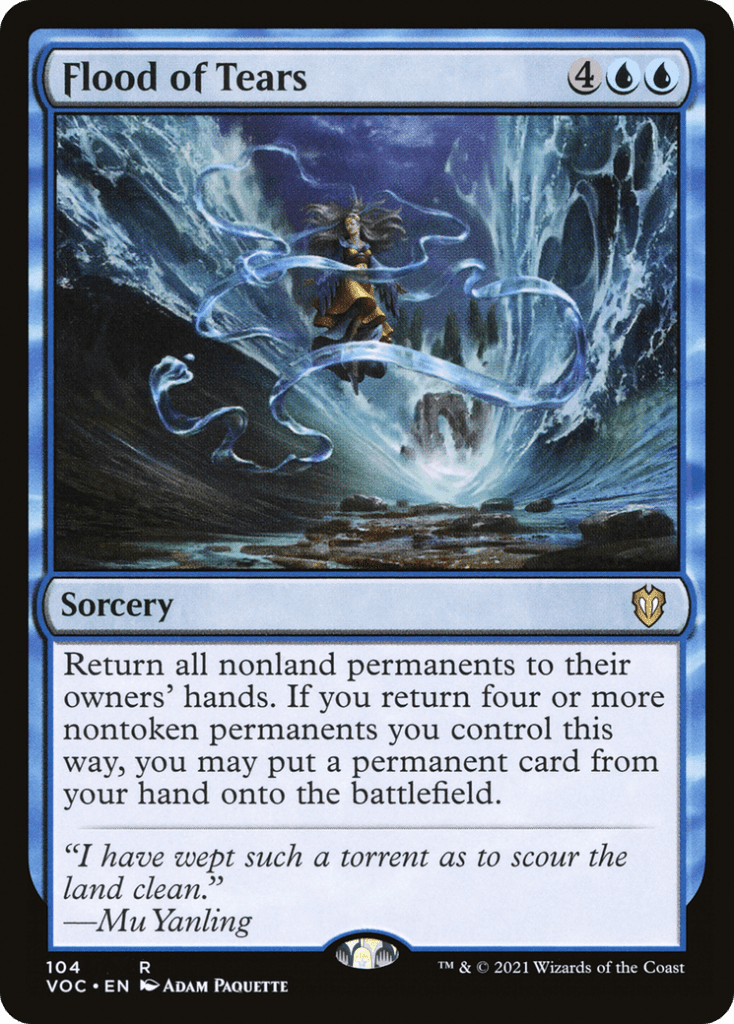
First, you typically don’t have to worry about indestructibility or instant speed effects that grant it until the end of the turn like Heroic Intervention. Despite being a popular foil for board wipes in many Commander games, indestructibility is completely worthless against a Flood of Tears or Kederekt Leviathan, often making your board wipe more effective.
Second, card effects that trigger when a creature dies won’t go off when you return it to its owner’s hand. This can prevent a lot of life loss from an errant Blood Artist, a nasty enchantment entering the battlefield via Academy Rector, or an extra bit of card draw via Skullclamp.
Finally, a mass bounce spell creates a major shift in tempo and can be extremely disruptive to short and long-term plans. Suddenly, your opponents have to consider which cards are actually important, assess how much they should replay, and in many cases, what they’re comfortable discarding to get down to the maximum hand limit of 7 at the end of their turn.
All while still clearing the board.
So which mono blue board wipes do the most work for the majority of Commander decks? I’ll be discussing my picks for the best situational and generally useful options, ranking the latter loosely from worst to best.
As with most things in Magic, however, I encourage you to do your own research on Gatherer or Scryfall as well – there are a lot of blue mass removal spells beyond those in this post, and while they will generally be the best options for many blue Commander decks, some metagames and strategies can allow you to benefit a lot from a niche effect or specialized variation.
Tribal Board Wipes (Cut the Tethers, Cyclone Summoner, Slinn Voda, the Rising Deep, Whelming Wave)
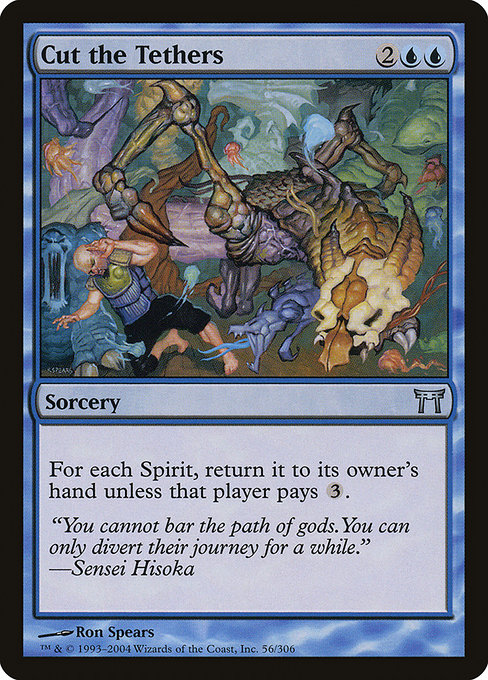

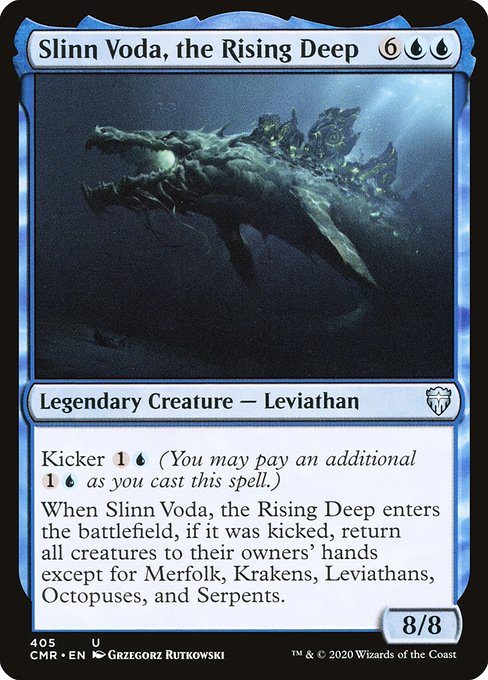

Blue’s tribal board wipes tend to fall in two camps – extremely helpful or utterly useless. Whelming Wave is easily the best among them, as it easily functions as a 4 mana mass bounce spell that will almost always sweep away all creatures in play. If you’re playing it in a sea monster deck, it’s a great card to close the game or buy time until you can cast 6+ mana creatures.
Slinn Voda, the Rising Deep is also a pretty solid inclusion for decks playing Krakens, Leviathans, Octopuses, and Serpents, acting as another copy of Whelming Wave that also happens to be attached to an 8/8 body.
It’s also interesting that Slinn Voda also includes Merfolk, particularly given their large selection of smaller, more efficient creatures. Unfortunately, adding one more tribe that isn’t affected by its mass bounce effect doesn’t really open it up to all that many more Commander decks, as it still costs 10 total mana to harness its full potential.
Cyclone Summoner is generally going to see more play in Wizard decks than Giant decks in Commander, especially given how many powerful Wizard creatures are available in blue, but it’s perfectly capable of doing a more fair Cyclonic Rift impression for either deck while also contributing a 7/7 body to your battlefield.
That said, 7 mana is still a very big ask for a color that likes to keep mana up for counterspells and other instant speed tricks, so while you can play it in the mid game once you have access to that mana, it’s usually better to wait until you can have 9 or more mana so you aren’t putting the shields down for a full turn cycle simply to board wipe.
Cut the Tethers is the only targeted tribal board wipe blue has to offer, and it isn’t for an especially relevant tribe. Unless someone in your playgroup is going out of their way to be a problem with a Celestial Kirin deck, this isn’t a card you should consider for most builds.
It isn’t even good in a Spirit deck due to being a sorcery, so there isn’t even the fringe benefit of avoiding a more destructive board wipe without also having a card like Leyline of Anticipation in play.
Color Hosers (Acid Rain, Hibernation, Llawan, Cephalid Empress, Wash Out)
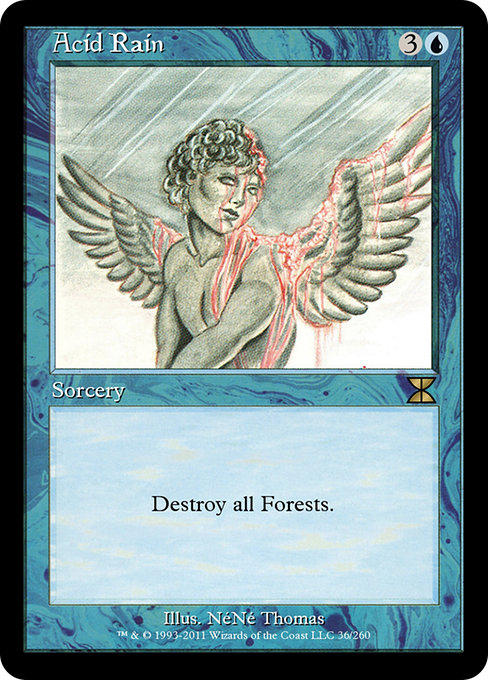
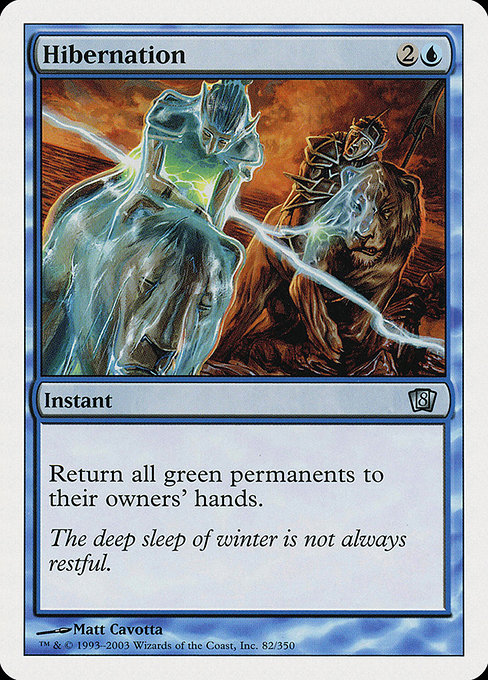
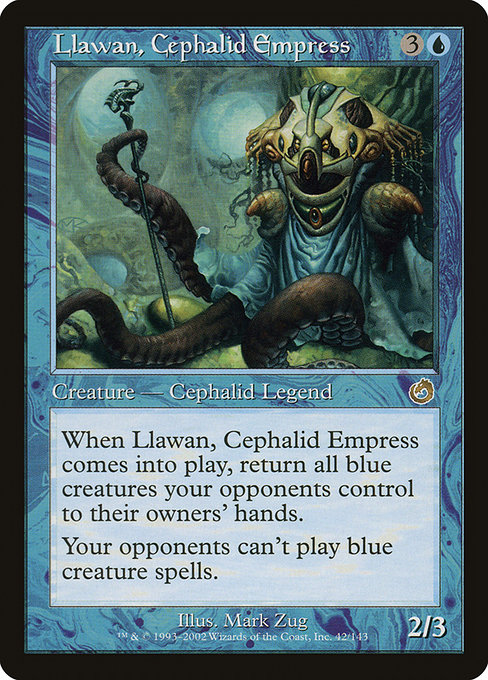
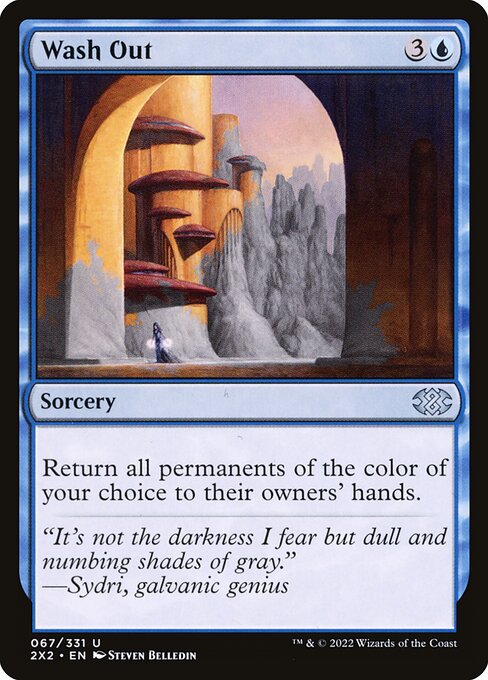
Are green creatures overrunning your meta? Does the prospect of looking at one more forest fill you with revulsion? If so, blue has a couple potent board wipes that are tailor-made to punish green decks: Hibernation and Acid Rain.
Hibernation returns all green creatures to their owners’ hands at instant speed for a mere 3 mana, ensuring your opponent can get all their biggest, most mana intensive bruisers onto the battlefield before you undo their efforts. One moment, they’re a threat to the table, the next they’re an easy target for anyone who wants to take a free shot during the next turn cycle.
Acid Rain, while much harder to come by due to the Reserved List, is a much nastier answer for mono green decks as it simply destroys every Forest in play. Sure, it might splash onto the occasional Breeding Pool or Indatha Triome on other boards, but a quick reminder of the events that led you to play Acid Rain in the first place should quickly smooth any ruffled feathers.
If your primary rival is a fellow blue player, Llawan, Cephalid Empress should be your silver bullet of choice instead. No backlash against your own creatures for playing it, no chance of your opponent playing most Clone effects to copy your game plan, and a solid way to restrict the creatures any deck using blue can even put into play.
Just watch out for Bribery or reanimation spells, especially if you’re playing a mono blue deck. there are plenty of ways to turn Llawan back against you, and if you aren’t prepared for that scenario, you can easily wind up in an extremely vulnerable position via your own effect.
For those who truly want to be prepared for anything, however, no color hoser is quite as flexible as Wash Out. Addressed to “whichever color it may concern”, you can send all permanents that your choice back to their owners’ hands. If you’re feeling particularly destructive, you can even combo it with Painter’s Servant to clear the entire board, lands and all.
Be prepared for what comes after if you pursue this combo though. Most opponents will be reaching for every tool at hand to demonstrate their displeasure for effectively resetting the game – especially if you can’t follow up your board nuke with an efficient way to win.
Artifact Board Wipes (Hurkyl’s Recall, Rebuild)
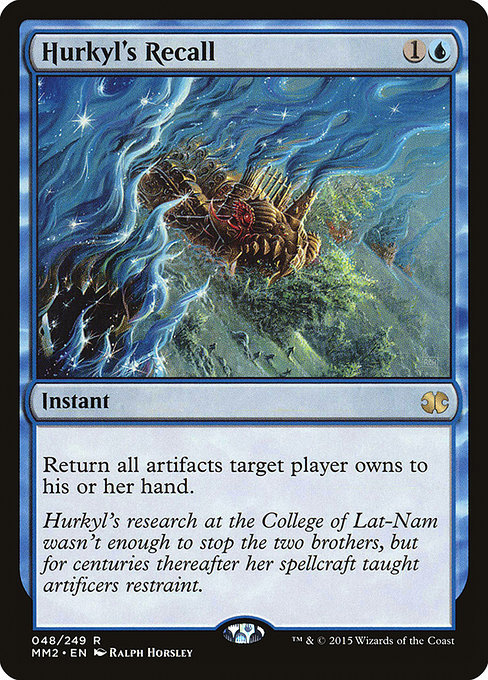
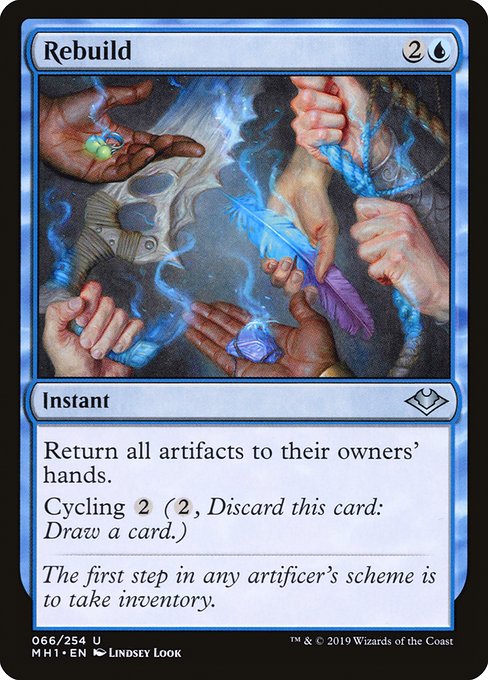
Generally, I don’t love mass bounce spells for artifacts in Commander. The majority of the cards you’ll be returning are mana rocks, and while some enter tapped and therefore can’t be used for a turn (like Sky Diamond or Worn Powerstone), there are others like Grim Monolith or Mana Vault that you’re effectively untapping for opponents at a discount when you bounce them.
That doesn’t mean cards like Hurkyl’s Recall or Rebuild can’t be useful in Commander, but they’re only really helpful in or against artifact decks.
When playing these inexpensive spells to return your own mana rocks for a mana boost, you can quickly rack up a bunch of extra mana for a big play by bouncing multiple efficient mana rocks like Sol Ring, Mana Crypt, Mana Vault, and Grim Monolith. Just tap them for mana, play your bounce spell, replay them, and tap them again.
Artifact-centric commanders like Urza, Lord High Artificer or Arcum Dagsson are notorious for playing all these powerful cards, but there are also plenty of scenarios where they will have a lot of expensive artifacts that have been ramped or cheated into play without an easy way to repeat the process once all their artifacts are off the battlefield.
This can make replaying these high mana value cards a significant struggle until they get an engine going again, potentially giving you the window you need to bring them down.
Artifact and Enchantment Board Wipes (Reduce to Dreams)
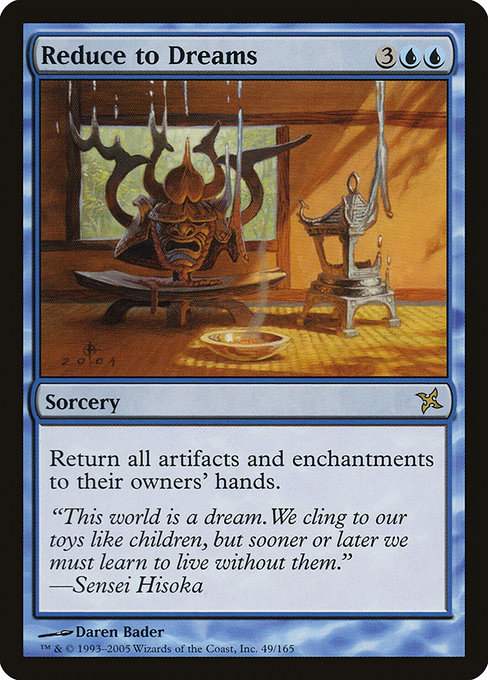
On one hand, I really appreciate the design space Reduce to Dreams occupies in MTG. No other blue board wipe specifically targets both artifacts and enchantments, and at 5 mana, it serves as a nice counterpart to Purify in white at a reasonable cost.
On the other hand, I really don’t understand why this card wasn’t an instant. Board wipes that bounce instead of destroying or exiling are already inherently weaker than their counterparts in most scenarios because there’s usually nothing preventing an opponent from replaying the cards you sent back to their hand on future turns.
I don’t know for sure that being an instant would allow a card like this to see a ton of Commander play, but in a color that thrives on responsive interaction, a 5 mana sorcery speed spell better be doing something on par with giving me an extra turn or buying me some breathing room from the whole table. Reduce to Dreams does neither.
At best, it significantly disrupts one of a couple very specific types of strategies, and you could do that just as easily with a more all-purpose board wipe capable of slowing down all your opponents at once.
Mass Land Removal (Sunder)

Pseudo Armageddon. At instant speed. In a color known for being able to play many types of cards at instant speed. Sunder is definitely much more in line with what I want out of a 5 mana spell.
With low mana value mana rocks seeing more play in modern Commander decks, Sunder and other mass land destruction cards aren’t quite as backbreaking as they used to be, but that just means you might need to play 2 spells or wait until an artifact board wipe has been played by somebody else to slam the doors on your opponents’ ability to produce mana.
As with other board wipes, the best way to use Sunder is to pair it with a powerful creature or other threat that is capable of winning the game on its own. If you can’t cast a game-ending threat during the same turn, you can also pair Sunder with cards like Teferi’s Protection or Teferi’s Realm to simply return everybody else’s lands to their hands while keeping your own.
Doing so will put you so far ahead of your opponents that they’ll never catch up, giving you plenty of time to use blue’s abundance of card draw spells to dig for a game winning card or wait until next turn to untap and play the one you’re already holding.
Board Clears that Clear Multiple Permanent Types (Coastal Breach, Consuming Tide, Devastation Tide, River’s Rebuke)
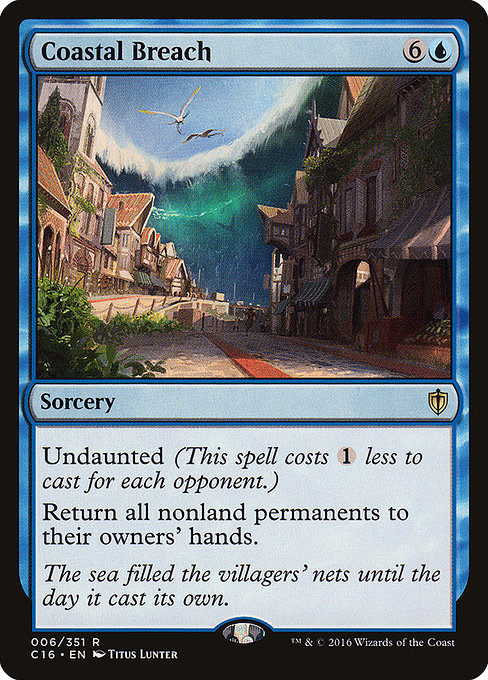

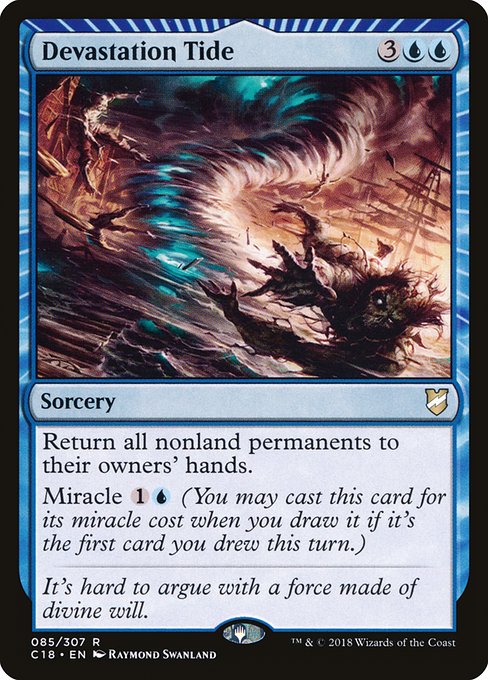

Returning all nonland permanents to players’ hands is always going to have a huge impact during a game of Commander. No matter which variation of this type of board wipe you use, the table will usually be reset to relatively even footing in the short term.
Sure, nothing is stopping the powerful cards you bounced from being replayed, but everyone will have the chance to take them as they come rather than being crushed by the might of the player with the strongest board position.
In a worst case scenario, everyone will usually get a turn of breathing room as players balance the tasks of rebuilding their boards and interacting with their opponents. Sometimes, the board state will resemble its old self when all is said and done, and other times something like a second board wipe can put a player earlier in the turn order far behind.
Coastal Breach and Devastation Tide are among the most straightforward of these effects, as both bounce nonland permanents without discrimination and have cost reduction mechanics that make them a very low mana investment so you have leftover mana to rebuild with.
Which of these two blue board wipes you prefer tends to depend on your playstyle and playgroup. If you have a lot of 4+ player Commander games, Coastal Breach‘s “always on” cost reduction is going to be pretty attractive, as it requires no setup at all.
Devastation Tide, by comparison, does require some setup to cast it for its Miracle cost of 2 mana, but with access to cards like Mystical Tutor, Scroll Rack, and Sensei’s Divining Top, and can even be cast on an opponent’s turn if you draw it as your first card. It also doesn’t care about player count, removing an external factor you won’t have control over for its cost reduction.
Consuming Tide provides an interesting take on this mass bounce effect, allowing each player to keep one nonland permanent of their choice on the battlefield when it resolves. This won’t solve every problematic board state, but it does a lot of heavy lifting for 4 mana, and doesn’t require any setup to be a very good inclusion in most Commander decks.
Finally, we come to River’s Rebuke, a card that saw an absolute ton of play when it was released in Ixalan, but it is also a board wipe I haven’t seen much of recently. Wiping a specific player’s board is very reminiscent of Cyclonic Rift, and will usually devastate whoever this spell hits, no matter how far ahead they are.
I suspect the decline of River’s Rebuke can be blamed almost entirely on Deflecting Swat, as nobody wants to invest 6 mana only to have their targeted board wipe pointed back at them for free, but I personally don’t think this potent spell is all that much worse now than it was years ago. Well worth the slot in many decks, especially if you’re looking for tools to close a game.
Inundate
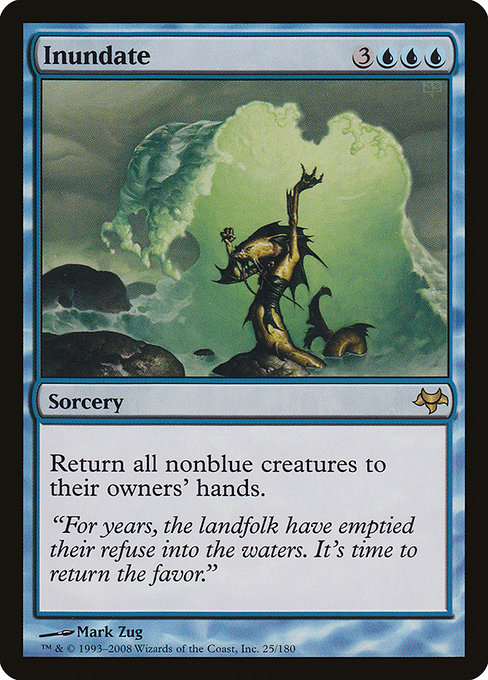
Inundate is a board wipe that I’m shocked so many blue decks sleep on. In pods that don’t have many other blue players, it’s basically a second Cyclonic Rift that only costs 6, and is only less devastating because it has to be cast on your turn in most cases.
The more blue players there are, however, the less effective Inundate becomes. A River’s Rebuke that you can’t control or an expensive impression of Rebuild are not good at 6 mana, but in my experience, events like these tend to be pretty rare. You’ll almost always hit at least 2 players with this board wipe, which makes it quite good much of the time.
If the worst case scenarios Inundate presents are holding you back from trying it out in Commander, I’d recommend adding cards in your deck that can use Inundate outside of its board wiping prowess. Common examples of cards I play alongside it include Frantic Search, Windfall, and Force of Will.
These are all great cards on their own for most blue decks anyway, so the fact that they can easily keep Inundate from cluttering your hand during games with a heavy blue presence is simply a bonus.
Engulf the Shore
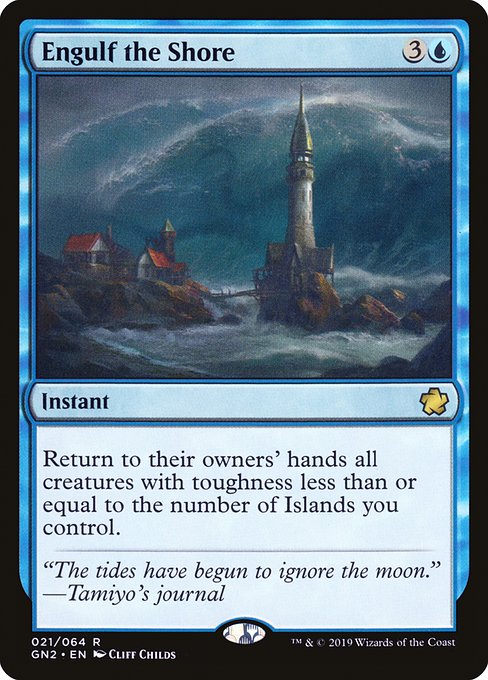
Instant speed board wipes are almost always worth paying attention to, and Engulf the Shore is no exception. While its reliance on Islands does place some restrictions on deckbuilding, they don’t have to be basic Islands, so any multicolor deck that can consistently put several Shocklands, Triomes, or Tango lands into play can also get mileage out of this board wipe.
That said, Engulf the Shore will usually be at its best in a mono blue deck. There’s simply much less reliance on nonbasic lands in a monocolored build, which minimizes the need to worry about playing enough Islands to comfortably return most creatures on the battlefield to their owners hands.
4 mana is also an incredibly good rate for an instant speed board wipe. While it isn’t always easy to hold up that much mana for a combat trick, it’s often well worth it to trip up someone who overextended their resources at the start of their turn or was a little too cocky when declaring attackers.
Spectral Deluge

Spectral Deluge looks like a worse Engulf the Shore at first glance, but despite being more expensive and limited to sorcery speed, it does a couple things so well that it edges out the previous entry.
First, Foretell is an amazing mechanic for making an expensive mana cost much more manageable over time. Simply exile Spectral Deluge early in the game for 2 mana, wait several turns for your opponents to forget about it, then surprise them after you’ve built up some lands for a mere 3 mana, allowing you to follow up with a game winning card immediately afterward.
And if you draw it late, you can still cast it for 6 mana in a pinch. Expensive, but better than being a completely dead draw in a pinch.
Second, Spectral Deluge only returns your opponents’ creatures back to their hand. One-sided board wipes are incredibly strong because you don’t have to spend time replaying your cards and can immediately declare attackers against boards that previously would have been impossible to get through.
Or put another way, “Tempo disruption for thee, not for me.”
I missed this card when it was released due to the sheer product deluge we’ve gotten from Wizards of the Coast lately, and given that I haven’t seen it in my pods, I bet I’m not the only one. If you like playing with Islands (or turning cards into Islands with cards like Quicksilver Fountain), Spectral Deluge is definitely worth testing in your deck.
Evacuation and Perplexing Test
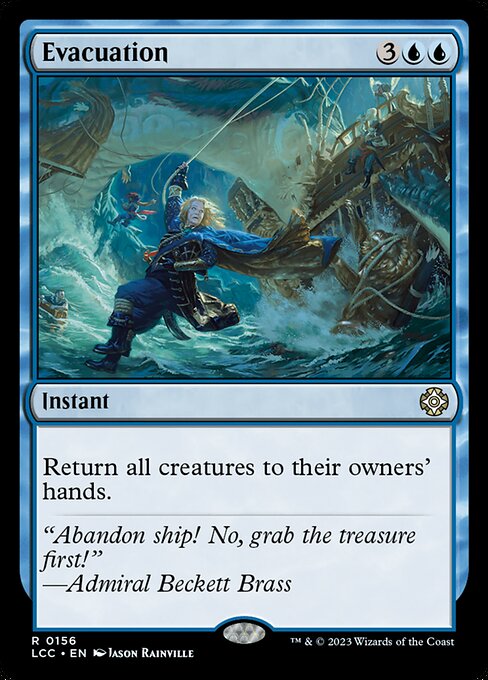

Evacuation has gotten me out of a ridiculous number of bad Commander situations over the last decade. 5 mana is a little steep for board wipes these days, but as an instant, I frequently find myself overlooking this little detail as I build any deck including blue in its color identity.
Whether you’re staring down a horde of token creatures or a surprise Blightsteel Colossus, Evacuation‘s lack of restrictions or setup requirements make it capable of addressing almost any creature-related problem in the moment – with the tradeoff of bouncing all your creatures in the process.
Naturally, this means timing is extra important when playing Evacuation. Setting an opponent back is almost always good, but if you’re setting yourself back as much or more, that usually isn’t a good trade unless you’re staring down a lethal attack.
On the other hand, if you have are utility creatures like Snapcaster Mage or Archaeomancer, getting some extra uses out of their enter the battlefield abilities can add a little extra value to tip the scales slightly further in your favor.
Perplexing Test has all of the same merits as Evacuation, but also allows you to choose whether you’re targeting token creatures (which will permanently disappear them) or nontoken creatures. This is especially good in or against decks that lean on tokens, as you can easily target a specific type of problem without necessarily having to set yourself back in the process.
If you’re in a situation where you want to deal with both types of cards and can’t, however, Perplexing Test is going to live up to its name as your threat assessment skills are put to the test.
The Phasing of Zhalfir

The Phasing of Zhalfir is probably the most impactful board wipe blue has ever gotten. While we’ve seen cards similar to it in Pongify and Curse of the Swine, blue had never gotten a card that simply says “Destroy all creatures.” before. At only 4 mana, it’s also incredibly well costed for a mechanically unique effect in this color, so it will see a lot of play for years.
A major part of what makes this card so good is the read ahead mechanic. Since you can simply skip to the final chapter when it enters the battlefield, The Phasing of Zhalfir is able to be a blue Wrath of God. Yes, the destroyed creatures are all replaced with 2/2 creature tokens, but that’s still a very simplified board state in most instances.
If you don’t need or want to board wipe right away, you can set up The Phasing of Zhalfir to go off in 1 or 2 turns, phasing out a creature you really want to keep if your enchantment survives long enough to nuke the board, or temporarily removing a big or indestructible threat that you aren’t able to deal with in any other way.
Read ahead also doesn’t care about where your Saga was played from, so if you have a way to recur enchantments reliably, you can easily keep nuking the board and replacing all creatures with 2/2s as long as is necessary.
Note that the creatures destroyed do not have to be nontoken creatures, so The Phasing of Zhalfir can’t fully clear a board by itself. It also won’t do much to a token deck – having a Perplexing Test or another creature board wipe on hand might be very worthwhile as a follow-up move if you find yourself short on 2/2s to protect yourself.
Cyclonic Rift
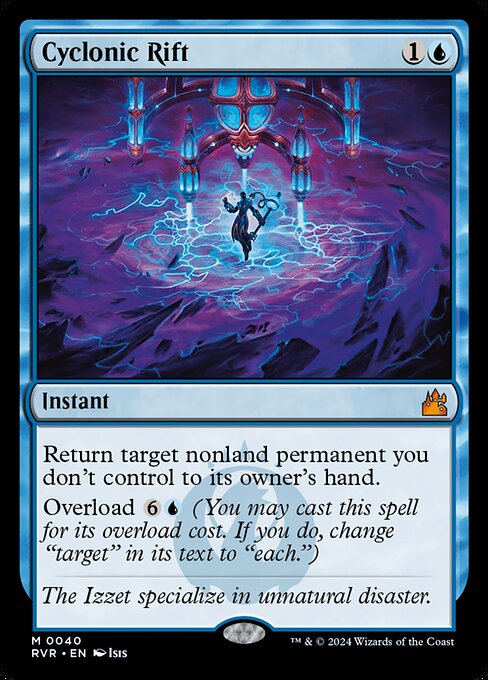
Cyclonic Rift is one of the best board wipes in Commander. It only hits your opponents, is potent when used offensively or defensively, can be played as cheap spot removal in a pinch, and is simply one of the most efficient 7 mana spells you can play in a vacuum for what you get. It also only has 1 blue pip in its cost, so it’s very easy to cast compared to a board wipe like Ruinous Ultimatum.
This has led to Cyclonic Rift becoming an auto-include for any blue deck in Commander, and the merit of its banning has been a heated topic of discussion for years.
Personally, my opinions on Cyclonic Rift’s legality in Commander haven’t changed since 2020. While something always has to be the best, Cyclonic Rift is just too much better than its peers at what it does for it to be an entirely healthy part of the format. So much so that I could have named this post “Cyclonic Rift Alternatives”, and nobody would have batted an eye.
But since it’s still legal, I can’t recommend not playing it (and I’d be an absolute hypocrite to boot). Most decks that can run this board wipe are simply better for doing so, and there is ample evidence to back up that claim. Cyclonic Rift wins games, plain and simple.
Which Board Wipes Should I Play in Commander?
This isn’t a question that’s going to have a hard and fast answer, but there are a few things to consider that can help you narrow down your options to the best few cards:
- Mana Cost: The less mana your board wipes cost, the earlier in the game you can use them. In later stages of the game, a low mana cost is also advantageous because it allows you to play more spells after wiping the board.
- Can this board wipe be one-sided: Board wipes that affect your opponents more than you don’t disrupt your tempo when you’re deadlocked or ahead while still clearing the board effectively if you end up falling behind your opponents.
- Is this board wipe an instant: Blue gets access to the best instant speed board wipes in Magic. Disrupting an opponent’s board after they spend mana but before you untap will give you free reign to cast spells and attack while their defenses are down.
From there, review the options available to your commander’s color identity and choose the spells that will be the best fit for the needs of your deck and your metagame. While this usually works out to be between 4 and 6 cards, if you play fewer creatures, don’t be afraid to add more board wipes to keep more creature-heavy decks off your back when needed.
Finally, get some playtesting in to see what works and what doesn’t, and use what you learn in your games to make changes to your deck. It’s very common for cards to perform better or worse in practice than they look in theory, so seeing how they play for yourself is the best way to optimize your deck for what it aims to do.
Other MTG Articles You Might Enjoy
- Cyclonic Rift Legality Discussion
- Best Blue Artifact Tutors MTG
- EDH Best Blue Mana Ramp Cards MTG
- EDH Best Green Board Wipes MTG
- EDH Best Black Board Wipes MTG
- Best Mono White Board Wipes Commander
Braden is a founder of Assorted Meeples and has been a gamer & writer with a vivid imagination all his life. Don’t believe us? Check out his excitement when meeting Goosebumps author R.L. Stine as a kid! An avid Magic: The Gathering spellslinger for over 15 years, you can always convince him to shuffle up for a game (or three!) of Commander.
